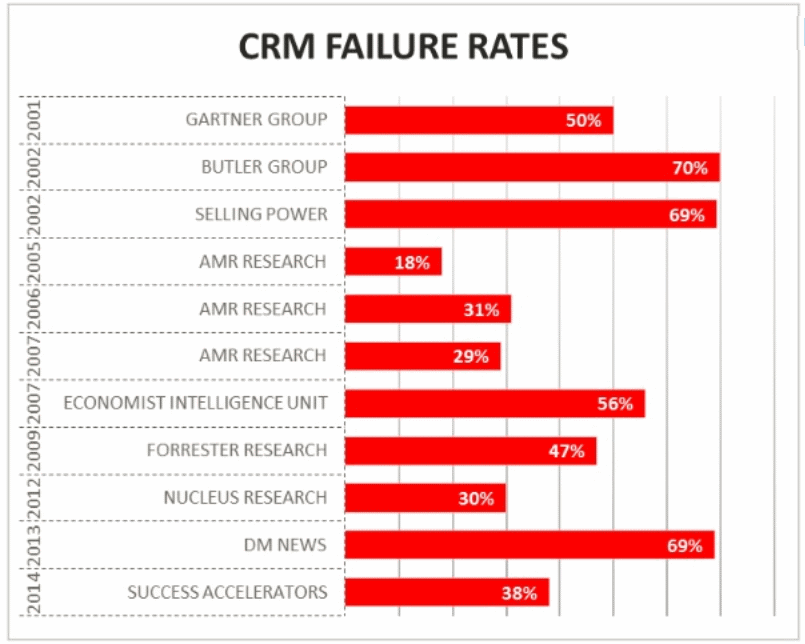Did you know that, according to studies conducted over recent years, 30 to 60% of CRM projects continue to fall short of their objectives? A trend also observed over a longer 13-year period (from 2001 to 2014 in the figure) with outcomes being the same, regardless of the solution selected, and even in cases where it is not the company’s first CRM project attempt! So what can be done to solve this problem and help you, at long last, achieve your goals?

1. The configuration of CRM solutions is business-specific
What does this mean? Well, that all companies tailor CRM solutions to meet their needs, i.e. adapt them in such a way that they suit their vocabulary, the manner in which they describe customers, their organization and their internal processes. This is why setting up a CRM solution differs greatly from deploying an office automation or telephony solution. The solution must be carefully adapted to fit the company through configuration and specific developments (including integration into the ecosystem).

And in spite of teams’ efforts and allocated budgets, the work is one that is never really done:
- At the time of go-live, there may be settings yet to be finalized…
- New use cases can be identified when the solution is in the hands of users, or some elements may turn out to be not as clear as previously believed…
- Needs may have evolved, such as the appearance of a new sales process, a new sales channel or Customer Service contact channel ….
Of course, any method that includes field testing will help reduce such risks and is thus worth considering: building in agile mode, deployment of a pilot before the roll-out to all users, a breakdown of the project into several batches with a pause between each batch, double acceptance (technical and business), examination of obstacles by teams responsible for change management…
2. CRM: ensuring effective operation over time
But there always comes a moment when the team in charge of solution building stops, the build phase ends and another mode kicks in; generally, one where the IT Department or a partner (seldom the business side, unfortunately) takes over to fix any remaining bugs and to ensure that the solution continues to function properly every day.
Little by little, players change, skills are lost and the time committed is limited to the strictly necessary… When CRM solutions are audited, several years after the initial go-live, it is not unusual to hear on the one hand, users complain about the solution whilst on the other, the IT Department claims that everything is going well.
However, according to studies, even if 30 to 60% of CRM projects continue to fall short of their objectives, this satisfaction rate can rise to over 60% after 2 or 5 years, if continuous efforts are made with regards to platform (fixes and upgrades) and training (users and managers). What should be done then given the current context?
3. A trend to consider: SaaS and Customer Success Management
Since the widespread deployment of solutions in SaaS mode, we have observed a growing demand for turnkey, one-stop, solutions in invitations to tender. We believe that SaaS is encouraging organizations to no longer perceive technical and functional skills (that constantly need to be updated or developed) as an in-house requirement.
But experience has shown that AMO (Application Maintenance Outsourcing)-type activities do not help improve satisfaction rates. If outsourcing technical and functional competencies has definitely helped reduce costs, it has done so without however addressing the real issues: namely user adoption and the achievement of business goals initially set during the launch of the CRM project.
A new approach is thus emerging, generally referred to as Customer Success Management. Whereby the main focus is on the integration partner’s ability to help business functions develop their activities rather than on the tool’s operational maintenance. An effort that goes beyond maintenance in operational condition, the ability to quickly deliver developments, the regular presentation of upgrades proposed by the solution vendor or refresher courses for users through recurrent training sessions.
4. Banking on minor proactive actions (MPA)
Using numeric indicators and a clear roadmap, it should be possible for the integration partner to undertake “minor proactive actions” with regards to the solution and the users, that will help the company achieve its goals. For example, if the objective is to improve B2B customer relationships, several performance indicators can be defined in order to objectively measure business user adoption and the benefits derived from the CRM solution: completeness rate of customer records, time it takes to submit visit reports, number of action plans defined and monitored in the CRM…
What do we mean by “minor proactive actions” (MPA)? Major upgrades are not the solution to every problem. In fact, MPAs are often quite the opposite; they are simple and quick steps taken by experienced consultants who are in direct contact with the company’s business, challenges and constraints, and the technical ecosystem:
- Reviewing a screen’s user-friendliness (customer record, appointment sheet…)
- Improving summary lists’ content and coherence (my customers, my appointments, my priority tasks…)
- Fine-tuning options in fields such as drop-down menus
- Adding a summary indicator in the customer record or a summary list
- Adding a graphical overview
- Training new users….
- Calling struggling users ….
5. A new contractual relationship, a new form of AMO
With a whole range of key indicators under his responsibility, a roadmap and a “minor proactive actions” implementation process (for instance: rapid release in cases where the fix is obvious and risk-free, and slower release when a pilot phase is required), the integration partner can now commit to goals and relieve the company of a lot of the tasks that need to be performed to increase their CRM solution’s satisfaction rate.
Regarding commitment and responsibilities, the integration partner must be given the means necessary to conduct his actions. Financing must thus take the form of a fixed annual budget and/or a target-based bonus. More specifically, once the user adoption criteria are defined, a growth target for the year can, for example, be set and bonus terms and conditions attached to it.
Note: it would be fairly logical to expect the 20/80 rule to apply in such a context. 20% of initial MPAs could contribute to 80% of growth with respect to objectives, a point after which progress would become increasingly difficult to achieve. Contracts must thus provide for fair remuneration with regards to efforts undertaken over several years (3 years or less).
















Your email address is only used by Business & Decision, the controller, to process your request and to send any Business & Decision communication related to your request only. Learn more about managing your data and your rights.